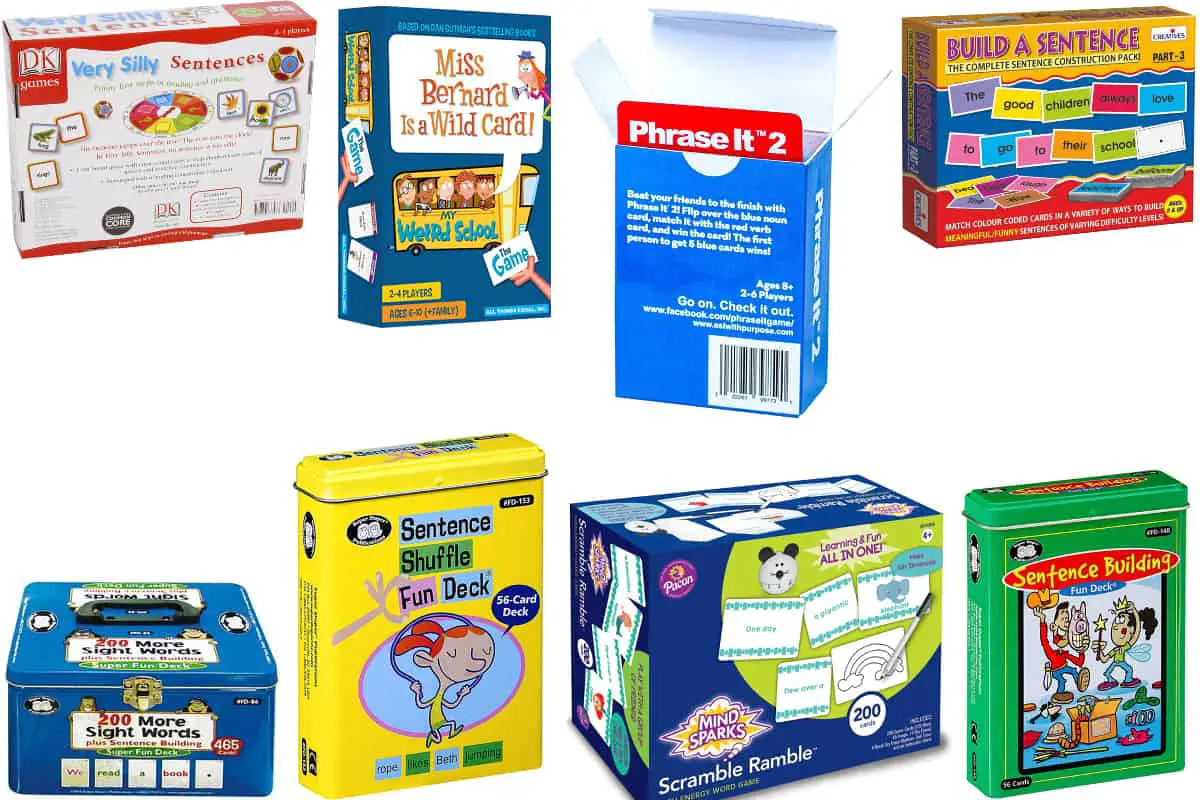This post contains affiliate links.
Sentence building card games make children more excited to learn about the topic and better master vocabulary, spelling, punctuation, and putting thoughts together in a coherent way. Those are essential skills since 73% of employers want candidates to have strong writing skills.
want candidates to have strong writing skills.
I found nine sentence building card games, which can be divided in
- Kindergarten games such as Scramble Ramble
- Elementary school games like Miss Bernard is a Wild Card
- Scramble Ramble, which can be used up to high school and uses the Strategic Instruction Model (SIM) Sentence Writing Strategy
Sentence Building Card Games Comparison Table
These nine card games for sentence building help children of all ages master the ability to construct different types of sentences. They’re easy to use and provide great support for lessons about sentence building.
| Game | Age | Players | Price | Rating |
200 More Sight Words Plus Sentence Building | 3‑6 | 2-4 | $$$ | ★★★☆☆ |
Very Silly Sentences | 3‑5 | 2-4 | $$ | ★★☆☆☆ |
| Scramble Ramble | 4‑8 | 2+ | $$ | ★★★★☆ |
Sentence Shuffle Fun Deck | 6+ | 2-4 | $$ | ★★★★☆ |
Miss Bernard is a Wild Card | 6‑10 | 2-4 | $$ | ★★★★★ |
The Sentence Zone | 6+ | 2-6 | $$$$ | ★★★★☆ |
Sentence Building Fun Deck | 7+ | 2-4 | $$ | ★★★★★ |
Phrase It 2 | 8‑12 | 2-6 | $$ | ★★★☆☆ |
Build a Sentence Part 3 | 8+ | 2-4 | $$ | ★★★☆☆ |
Sentence Building Card Games for Kindergarten
200 More Sight Words Plus Sentence Building (Super Duper Publications)
★★★☆☆
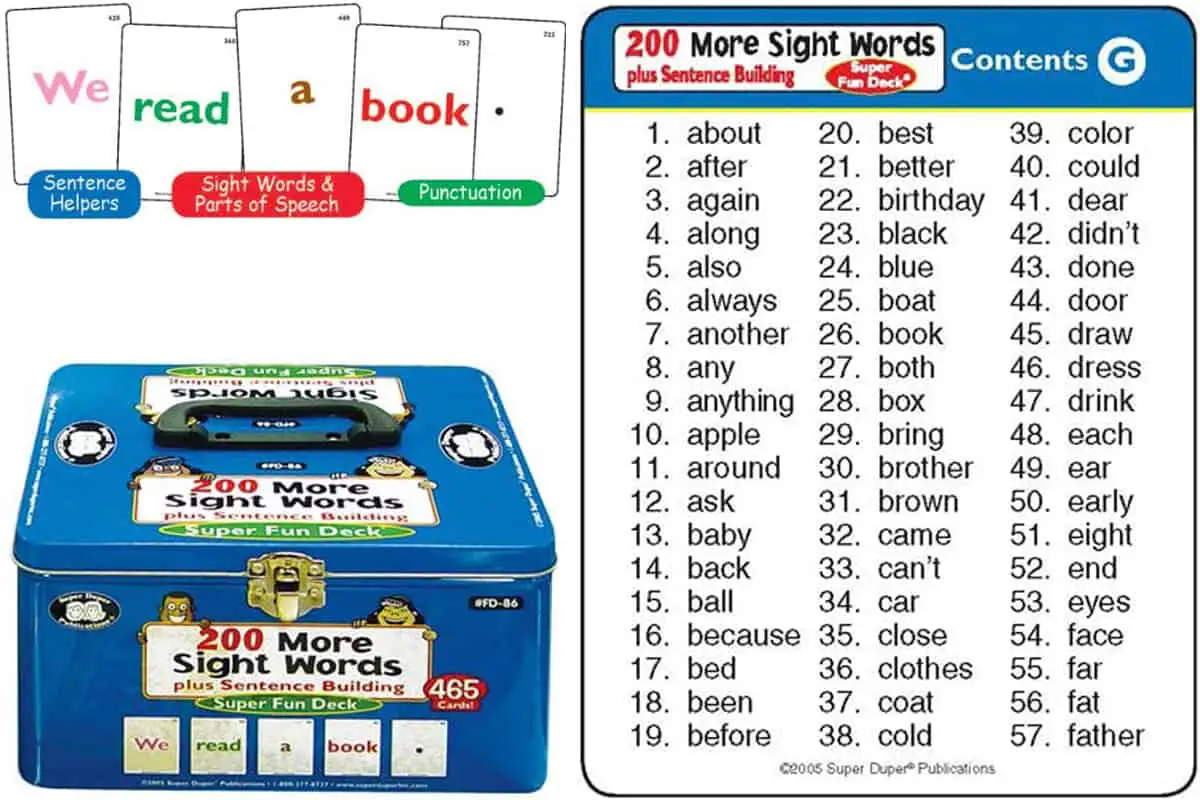
2‑4 players | Age 3‑6 | CCSS Grades: PreK‑K2 | Price $$$
This Super Duper Publications game is a follow-up to the First 100 Sight Words
is a follow-up to the First 100 Sight Words game (they can be used together). This game helps children learn words and build sentences with 465 color-coded cards among which you can find:
game (they can be used together). This game helps children learn words and build sentences with 465 color-coded cards among which you can find:
- 200 sight words
- 22 sentence helper cards (A, Our, Please, …)
- 4 punctuation marks
- 92 adjectives
- Nouns, pronouns, verbs, adverbs, prepositions, articles, and conjunctions
This game is the sturdy metal container that houses the cards and the number of cards enables to cover a wide vocabulary. And the color coding enables to sort the cards and introduce the children to parts of speech.
There are two drawbacks with “200 more sight words” though:
- These are “just” flashcards, there are no rules to make this “game” fun
- The cards only have words. Children at the PreK level, or language delayed children in particular benefit more from cards that have both pictures and words (for concrete words) since they’re better able to associate the words with things they can visualize.
Very Silly Sentences (DK Toys & Games)
★★☆☆☆
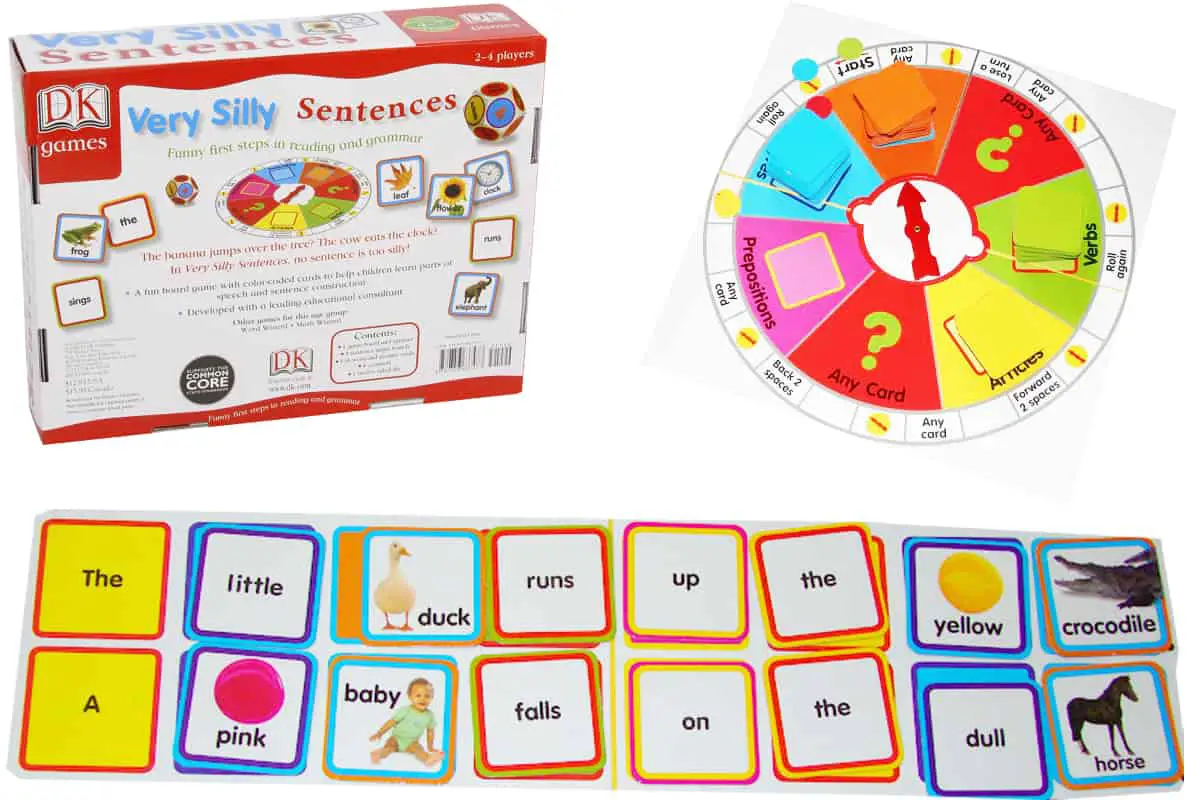
2-4 players | Age: 3-5 | CCSS Grades: PreK-K1 | Price $$
This sentence-building game is great for children from three to five years to learn the basics of grammar and sentence construction. The dice has to be mounted from a piece of hard paper. There is also a colorful spinner to complement the color-coded cards that identify the parts of speech being used. Another highlight is the colorful cards that have images when the word is a concrete one.
is great for children from three to five years to learn the basics of grammar and sentence construction. The dice has to be mounted from a piece of hard paper. There is also a colorful spinner to complement the color-coded cards that identify the parts of speech being used. Another highlight is the colorful cards that have images when the word is a concrete one.
The premise of the game is good, but its construction is poor (quality of the dice and the game pieces). Furthermore, many of the completed sentences are grammatically incorrect. It can be OK at home but not at school.
Scramble Ramble Word Game (Mind Sparks)
★★★★☆
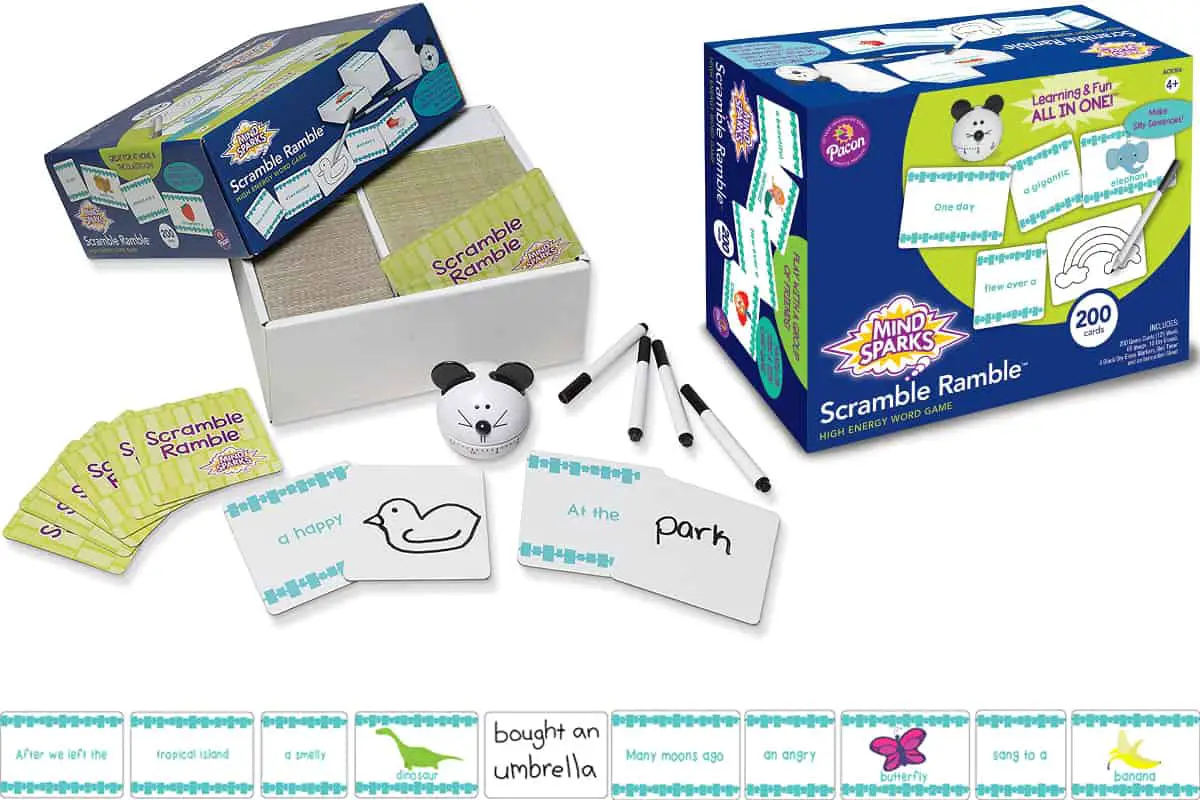
2+ players | Age: 4-8 | CCSS Grades: K1-Grade 2 | Price $$
Mind Sparks’ Scramble Ramble Word Game is a great way to put fun sentences together.
is a great way to put fun sentences together.
There are 200 cards:
- 125 with words only (generally 2 to 4 words)
- 65 with a word and an image
- 10 dry-erase cards
The game also comes with a timer and four dry-erase markers.
The principle of the game is to draw 10 to 15 cards and rush (either alone or by teams) to build a complete sentence with the cards, starting with a card that starts with a capital letter (the first to create a sentence wins). If you draw a dry-erase card, you can use it to write or draw a word on it and use it in your sentence. In the classroom, you can hide the cards.
The dry erase boards and timer make this game easily adaptable for an array of playing scenarios. Also, the choice of sentence bits that are written on the cards is carefully chosen to enable players to build grammatically correct sentences.
The readability of the cards could be improved though.
Sentence Building Card Games for Primary School
Sentence Shuffle Fun Deck Flash Cards (Super Duper Publications)
★★★★☆
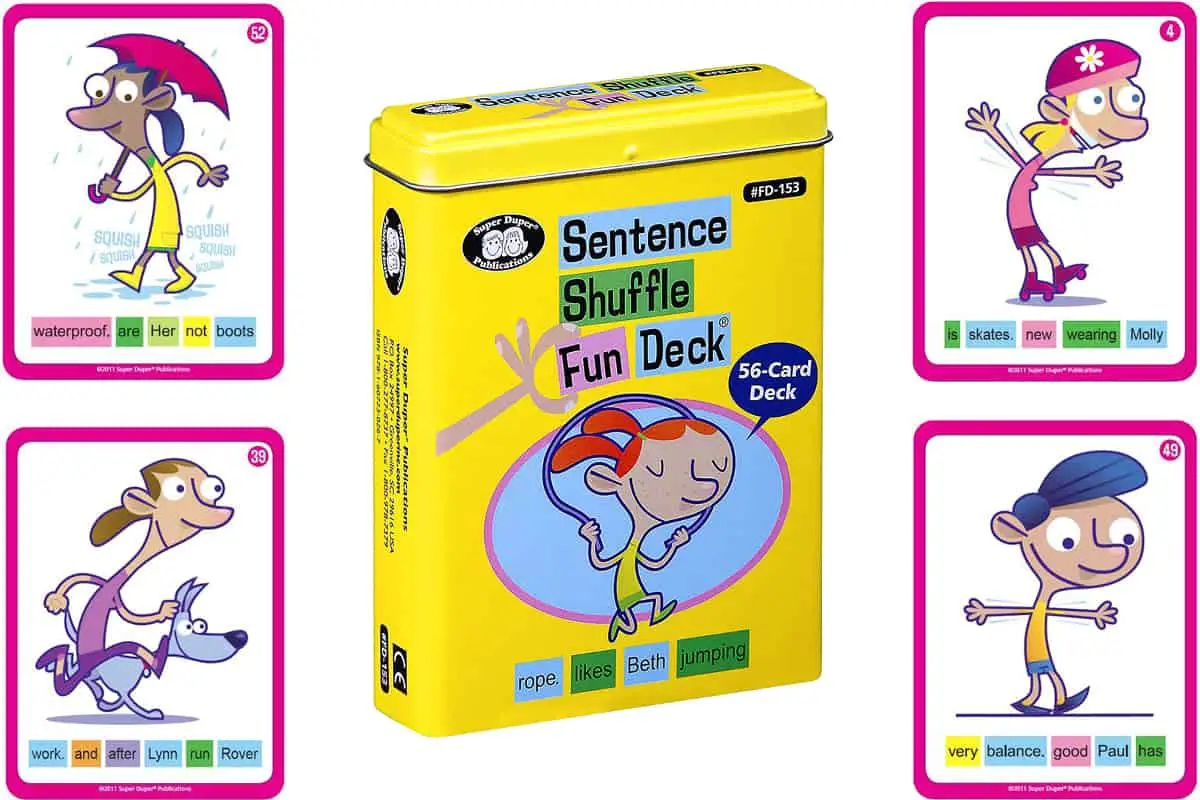
2-4 players | Age: 6+ | CCSS Grades: 1-4 | Price $$
Super Duper Publication’s Sentence Shuffle game is a nice addition to a lesson about parts of speech and sentence structure. It can also help students develop their reasoning skills as they work together (or individually) to determine whether the sentences they’ve created are logical.
is a nice addition to a lesson about parts of speech and sentence structure. It can also help students develop their reasoning skills as they work together (or individually) to determine whether the sentences they’ve created are logical.
Parts of speech are color-coded (8 colors for nouns, articles, verbs, adverbs, pronouns, prepositions, adjectives, and conjunctions). Each of the 56 cards contains a shuffled phrase with an illustration. An answer key accompanies this game since there are set answers.
This makes it easy for parents and teachers to track a child’s sentence building progress and enables them to start playing quickly (no preparation time).
But it hinders the child’s imaginative thinking, and there is no manipulation of the cards. Many of the other sentence building card games mentioned in this article allow players to create their own sentences since each card has a single word (or several words) instead of a phrase. I also regret that there are not several levels of difficulty.
My advice would be to mix both approaches (and therefore use two different games), as you do want children to be creative, but the task of putting words in the right order to make a sentence makes real sense.
Sentence Building Fun Deck (Super Duper Publications)
★★★★★
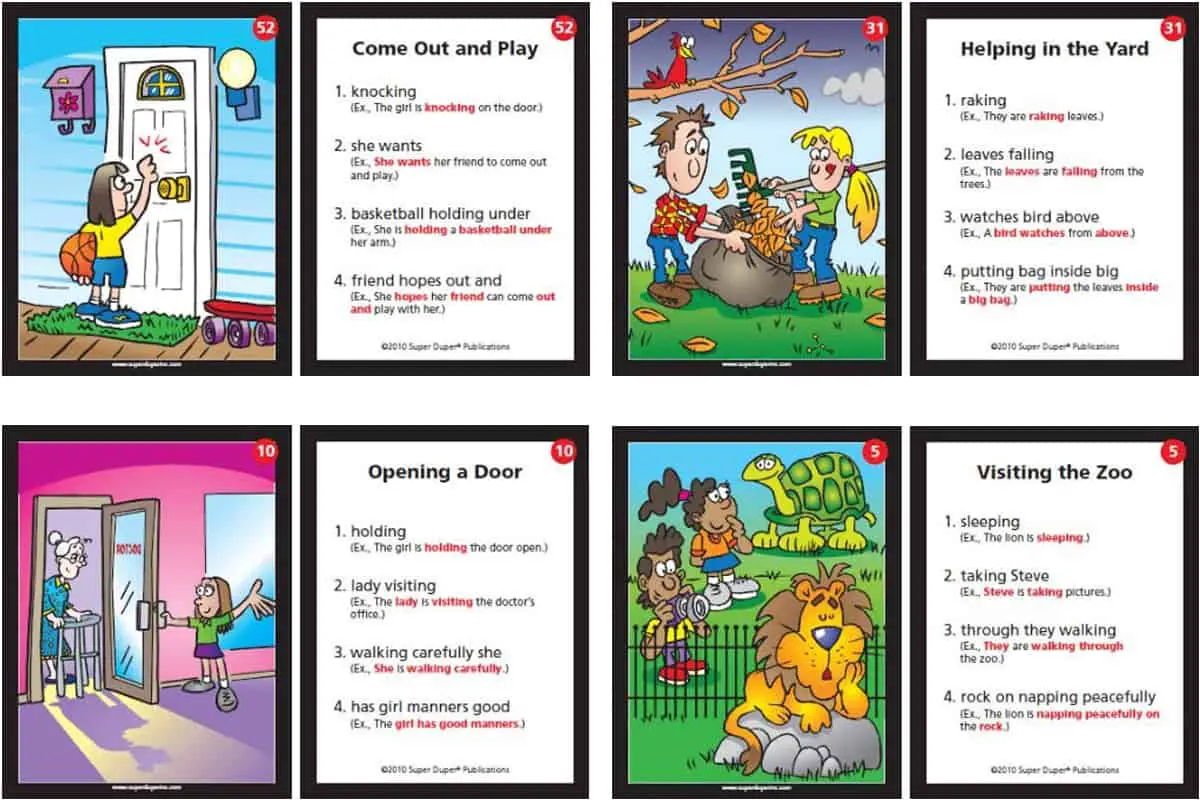
2-4 players | Age: 7+ | CCSS Grades: 2-5 | Price $$
This sentence building card game includes 56 cards, each with an illustration and four sentence prompts: the four levels of difficulty of these prompts (prompts contain 1 to 4 words) enable to teach to build simple, compound, and complex sentences.
includes 56 cards, each with an illustration and four sentence prompts: the four levels of difficulty of these prompts (prompts contain 1 to 4 words) enable to teach to build simple, compound, and complex sentences.
The game consists as the core rule to ask students to create sentences from the prompts using all the 1 to 4 words of the prompt (they might not be in the right order). 4 other ideas are proposed:
- Story builder: each player draws a card, writes a story, and reads eat to the other players.
- Circle stories: a card is drawn. Each player at their turn has to say a sentence that must add more information or complete the story that the preceding players have started. This is a very good rule for collaboration (you have to add to what the others have already built) and is similar to theater play improvisation techniques
- Student sentence building: Each player has to create a card just like in the games, with its title, illustration and the 4 sentence prompts
- Magazine sentence builders: teacher create additional cards by cutting magazine images
The game can be played with students in grades two and three for the simpler prompts, and is best suited for students in grades four and five for more complex prompts, and for the “story builder” and “circle stories” rules. Students will have to rearrange some of the sentence prompts, and include their own words, in order to create appropriate sentences.
Miss Bernard is a Wild Card (All Things Equal)
★★★★★
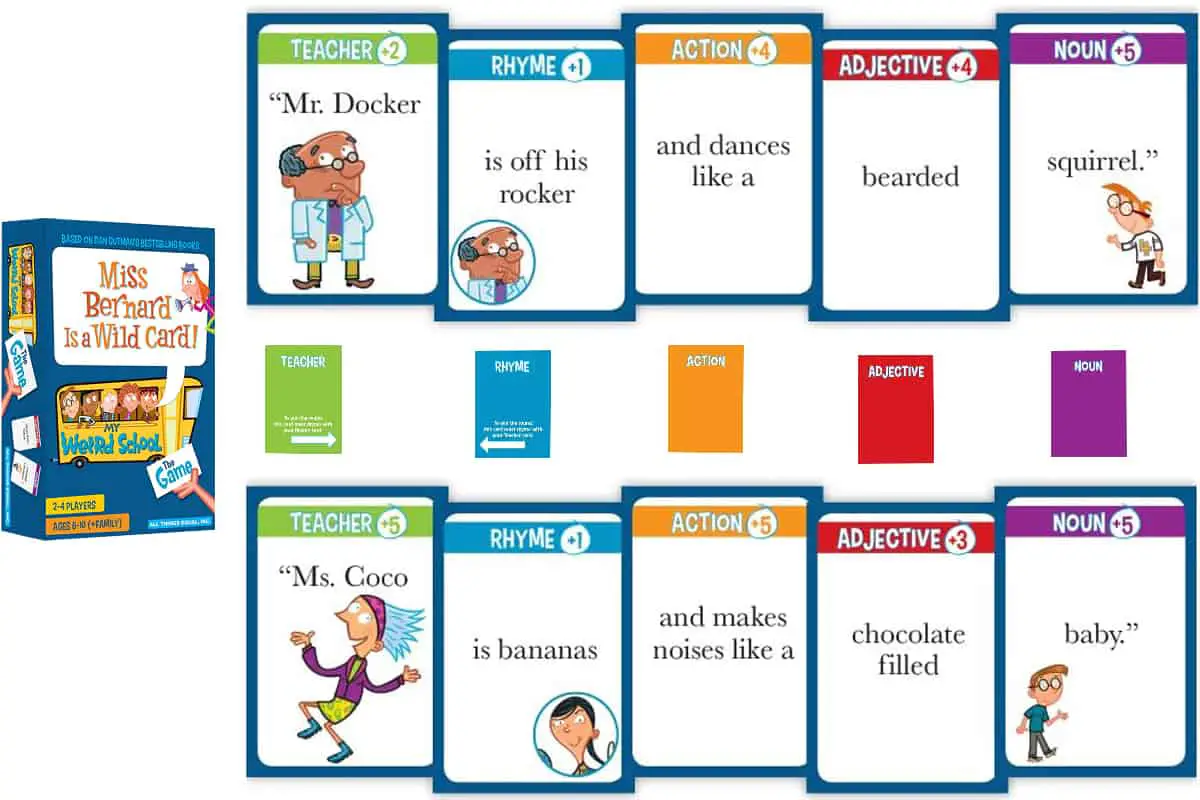
2-4 players | Age: 6-10 | CCSS Grades: 1-4 | Price $$
Students will have a blast creating funny sentences using Miss Bernard is a Wild Card . There’s even a catch – the first two parts of the sentences created must rhyme for a player to have a winning hand. Each sentence must be arranged in the following order: teacher, rhyme, action, adjective, and then noun.
. There’s even a catch – the first two parts of the sentences created must rhyme for a player to have a winning hand. Each sentence must be arranged in the following order: teacher, rhyme, action, adjective, and then noun.
As with “Scramble Ramble”, the 110 cards contain either one word or several words (a small piece of a sentence). The cards are much better illustrated though, the sentence groups funnier, and the rhyming adds even more fun to the game, making it a real game while “Scramble Ramble” feels more like an exercise formatted into a game.
“Miss Bernard is a Wild Card” provides real surprises when building the sentences, which makes it a great family game. Wild Cards are included and they can unexpectedly change the course of the game. It’s a game the entire family can enjoy! Your children won’t even realize they’re learning sentence building because they’re having so much fun.
Teachers will discover that this game is also relevant in the classroom. You can even add a bit of challenge to see which team can come up with the craziest sentences.
Phrase It 2 (ESL with purpose)
★★★☆☆

2-6 players | Age: 8-12 | CCSS Grades: 3-6 | Price $$
Phrases are the focus of Phrase It . English as a Second Language (ESL) learners will find this particularly useful as they learn to build phrases which they can then learn to combine into sentences. You may want to purchase Alex Bricker’s 87-page book
. English as a Second Language (ESL) learners will find this particularly useful as they learn to build phrases which they can then learn to combine into sentences. You may want to purchase Alex Bricker’s 87-page book to complement this game so that you understand the multiple ways to play it.
to complement this game so that you understand the multiple ways to play it.
The game contains commonly used words to help build your student or child’s basic English vocabulary. It would be great if the game helped students build complete sentences instead of phrases. Regardless, it’s still important for children to learn the difference between phrases and sentences, as well as how phrases can be combined to create complete sentences.
Build a Sentence Part 3 (Creative’s)
★★★☆☆
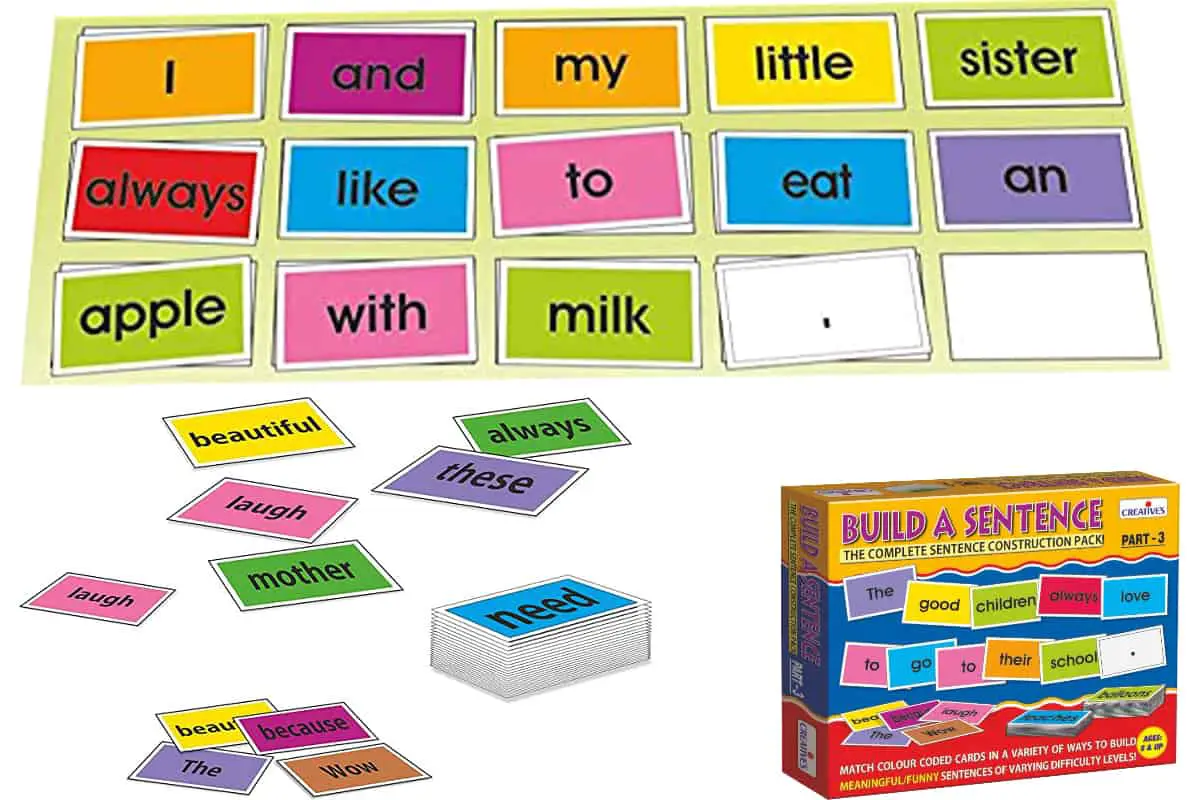
2-4 players | Age: 8-12 | CCSS Grades: 3-6 | Price $$
Creative’s Build A Sentence Part 3 features 360 double-sided color-coded word & punctuation cards (one word per card) so that children can easily identify parts of speech. It also includes two playboards and instructions with proposed activities. The cards allow students to create sentences ranging from simple to complex.
features 360 double-sided color-coded word & punctuation cards (one word per card) so that children can easily identify parts of speech. It also includes two playboards and instructions with proposed activities. The cards allow students to create sentences ranging from simple to complex.
I regret though that this is more a tool than a game.
Sentence Building Card Games for Middle School and Up
The Sentence Zone (Bonnie Terry Learning)
★★★★☆
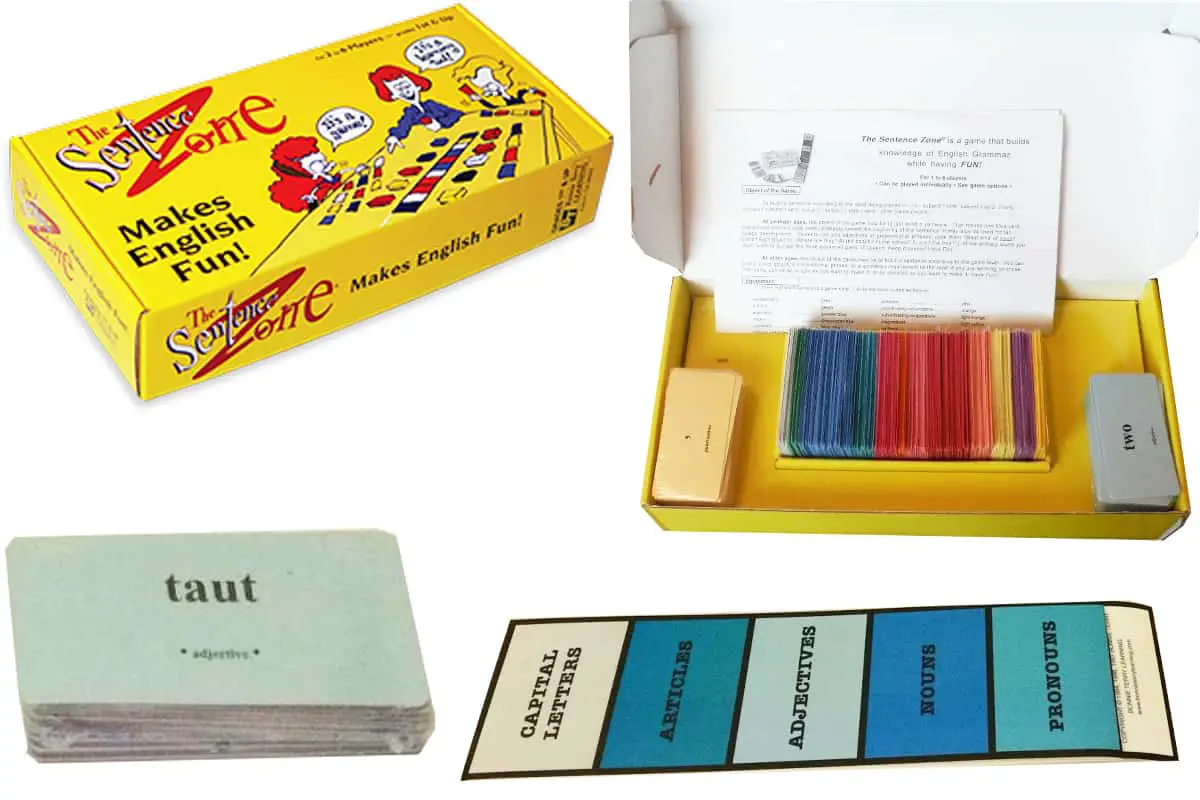
2-6 players | Age: 6+ | CCSS Grade: 1+ | Price $$$$
Of all the games on this list, Bonnie Terry’s Sentence Zone game has the widest application across age groups – up to SAT prep. There are six levels of play that range from very basic to more advanced. The 700 cards are color-coded so that players can identify the parts of speech used.
has the widest application across age groups – up to SAT prep. There are six levels of play that range from very basic to more advanced. The 700 cards are color-coded so that players can identify the parts of speech used.
Bonnie Terry’s sentence-building game follows the same approach as the “sentence writing strategy” from the Strategic Instruction Model (SIM) developed by the University of Kansas (and is supported by them on their website as a relevant implementation of their strategy, even if this is coincidental, the game having been created independently). Research results showed that students improved their percentage of complete sentences by 23% by using the SIM sentence writing strategy.
developed by the University of Kansas (and is supported by them on their website as a relevant implementation of their strategy, even if this is coincidental, the game having been created independently). Research results showed that students improved their percentage of complete sentences by 23% by using the SIM sentence writing strategy.
A Few Quick Tips about Using Sentence Building Games
- The best way to use these sentence building card games is as reinforcement after the lesson has been taught.
- How often you play a sentence building game with your child depends on how much support your child needs and how interested your child is in the game. Play these games too much and your child will lose interest. I would recommend closely assessing your child’s and playing a variety of sentence building games if your child needs continuous support.
- Sentence building card games aren’t your only options. You could also try sentence building board games.
Edudingo.com is a participant in the Amazon Services LLC Associates Program, an affiliate advertising program designed to provide a means for sites to earn advertising fees by advertising and linking to Amazon.com. We also participate in other affiliate programs which compensate us for referring traffic.

